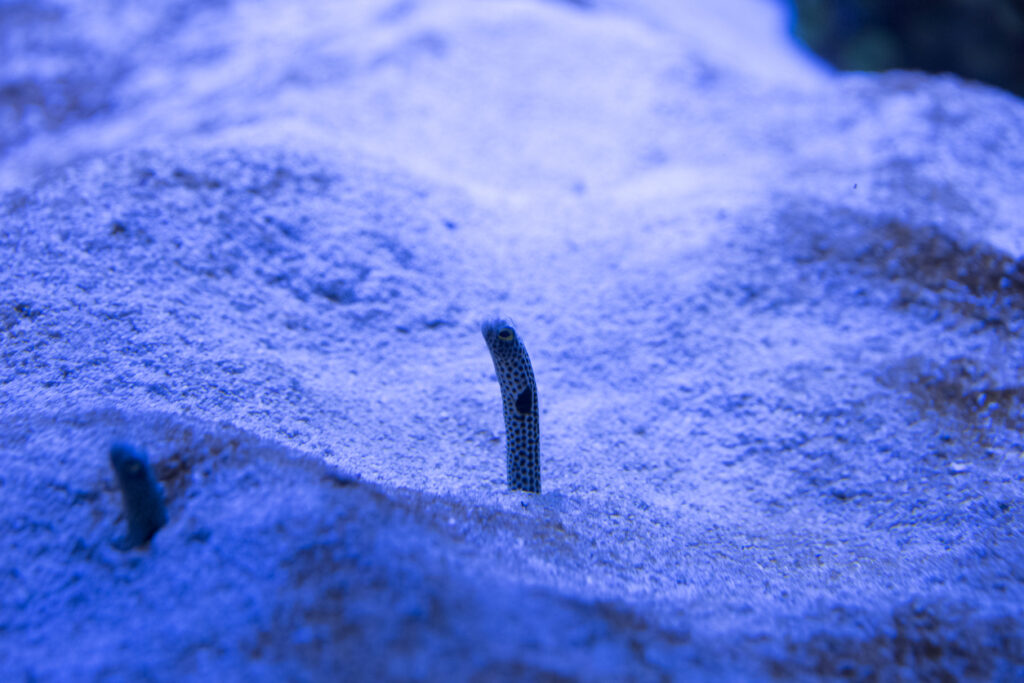You could easily mistake these tiny, straw-like creatures for seagrass if you weren’t paying close attention – but this species is actually a type of eel that embeds itself in the sea floor. They may be small, but this certainly doesn’t mean they aren’t interesting! We have plenty of facts to share about garden eels – so let’s get started!
What is a garden eel?
Garden eels are part of the subfamily Heterochongrinae, and over 30 species are thought to exist around the world. This includes the most common species, the spotted garden eel (Heteroconger hassi)and other species, such as zebra garden eels (Heteroconger polyzona) and brown garden eels (Heteroconger longissimus).
They get their name because when their bodies stick out from the sand, they resemble pieces of grass. Garden eels are a fairly recent discovery that came about in the late 1950s when scuba diving grew in popularity.
This type of eel has a typical lifespan of between 35 and 40 years. Their longer lifespan is thought to be down to their clever methods of protection against predators like dolphins, sharks and triggerfish.
What do garden eels look like?
Compared to other types of eels, these creatures are quite small and have smaller features to match. Growing up to just half an inch in diameter, they have slender bodies with one fin, a short nose and sharp teeth.
The only larger feature they have compared to other eels is their eyes, and thanks to these, they have good vision for seeking food.
Garden eels can also be a wide variety of different colours depending on the species, including blue, green, yellow, white, black, brown, orange and grey. Their appearance generally depends on which species of garden eel you’re looking at. Spotted garden eels, for example, have white bodies covered in small black spots with three larger spots highlighting their gills, pectoral fins and anus.

Habitat of a garden eel
These little creatures can be found around the world, from the Indo-Pacific and northwestern Australia to the Red Sea and East Africa. The majority of species prefer warm waters nearby to coral reefs.
Despite being fairly good at swimming, garden eels take the unusual approach of spending their entire lives burrowed into sand, either partially or fully. They use their tails to dig a hole in the sand, typically in strong currents or tropical waters up to 150m deep. Their bodies can secrete a type of paste, allowing them to stick to the sides of their burrows and keep themselves firmly planted.
They will usually only remove their tail from the sand to defend themselves, but this is a rarity. When they feel threatened, they can even completely bury themselves in the sand for protection.
One of the most interesting facts about how these eels live is that they tend to set up their holes close to one another. In fact, they can live in groups of around a thousand! But due to their shyness, you aren’t likely to ever spot a group, or any garden eel for that matter, out in the wild. Your best bet is to visit them in an aquarium since they’re likely to feel more comfortable popping out around visitors.
During mating season, garden eels will move their burrows to be closer to a mating partner. But even during mating, they will only intertwine the top half of their bodies together, leaving their tails tucked away in their burrows! Garden eels are pelagic spawners, which means they release their fertilised eggs into the water to float with the current on the surface until they hatch. Young garden eels will swim freely until their tails grow bigger and strong enough to dig their own burrows.
What do garden eels eat?
Using their excellent vision to their advantage, they can easily spot plankton floating by and drift their bodies back and forth to catch it without ever leaving the sand completely. Fish, eggs, crustaceans and types of shrimp also make up a small part of their diet.
We hope you’ve enjoyed getting to know this curious family of eels. At Bristol Aquarium, we’re home to our very own garden eels in our Coral Seas Exhibit. Book your tickets today to come along and say hello to them alongside all our other wonderful sea creatures.
